Edible Invasives - Eat Your Garden and Lawn Weeds
by George Powell
Are you distracted by dandelions? Perturbed by purslane? Stressed by sorrels? Don’t spray and pray your garden and lawn weeds away. Pull out your fork and enjoy the bounty of exotic edible greens at your doorstep.
Many of the common weed species that have infiltrated North America are introduced plants from Eurasia. Some of these ‘weeds’ have long been sought out as tasty, nutritious additions to summer fare in both the old country and new. They can add welcome variety to ordinary salads, or as steamed or stir-fried greens, and are often packed with nutrients and healthful phytochemicals.
What follows is a brief introduction to some common, and easy to identify, edible lawn and garden invaders that I’ve eaten.
Safety First
Before diving into the details though, I feel compelled to warn the casual back-yard forager that not every weed you will encounter is edible, and indeed, some are poisonous. Proper identification of prospective food plants is essential. If you have any reservations as to the identity, play it safe and don’t eat it.
Always wash your greens before eating them and don’t pick any that have been directly or indirectly subjected to pesticides. And don’t eat plants from public boulevards or out of ditches, as you can never know with certainty if they are free of unseen contamination.
On to the greens…
Dandelion, Taraxacum officinale
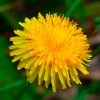
This ubiquitous, perennial lawn weed, springs forth a circle of elongated and irregularly-toothed, dark-green leaves from a deep, carrot-like taproot. Bright yellow flower heads are borne on ends of long, smooth, hollow stalks that arise from the middle of this rosette of leaves. When mature, the flowers are replaced by seeds tipped with a tuft of white hairs allowing them to parachute through the air.
Both the young leaves and flower buds of dandelion are great in salads or on sandwiches or lightly steamed like spinach.
Wild Mustard, Sinapis arvensis
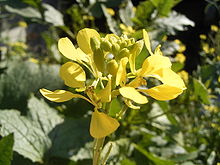
This annual weed of gardens, fields and pastures grows from 30- to 100-cm tall and is identifiable by the clusters of bright yellow flowers with four petals arranged in a cross pattern. The young leaves have a slightly rough texture, and sometimes with coarsely toothed and indented edges. The undersurface of the leaves have small hairs along the leaf veins, with slightly longer, stiff hairs near base of the stem. If crushed the leaves emit a familiar ‘mustardy’ smell.
Harvest only the early-growth leaves. They have a sharp, peppery taste and are good raw for spicing up a mixed vegetable salad. As a cooked green, wild mustard pairs nicely with bolder-flavoured meats. I enjoy mustard greens with pork or bison. The young flower buds of wild mustard can also be eaten raw or steamed like broccoli.
Chickweed, Stellaria media
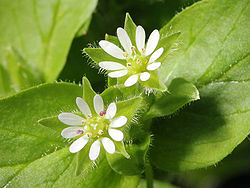
Chickweed’s many branched stems spread close to the ground and can grow over 30-cm long. Stems are covered by bright green, 1- to 2-cm long, pointed leaves that form in pairs.
This annual lawn and garden weed is delicious raw as a salad green, especially when the tender tops are harvested.
Lamb’s quarters, Chenopodium album
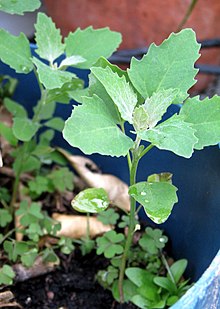
Somewhat variable in appearance because it can grow multiple stem forms. Lamb’s quarter can be recognized from its triangular (wedge-) shaped silvery blue-green, leaves that have a wavy indentation along the edge and somewhat resemble those of its botanical cousin, spinach. Flowers are very small, green and grouped together in clusters at the tip of the plant.
This garden weed can grow more than 2-m tall on rich soils. When young and small (<20 cm) the whole plant is tender and tasty. Upper (newer) leaves can be picked continually from older plants and eaten raw or steamed in the manner of spinach.
Purslane, Portulaca oleracea
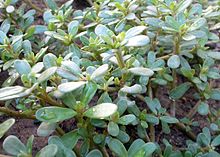
A common, ground-hugging garden invader. It can form circular mats up to 60-cm in diameter if you really get behind on your weeding. It has thick, succulent, deep-green oval leaves on reddish and equally watery stems.
Leaves and stems can be eaten raw or cooked, and the leaves can be frozen or pickled for storage. Purslane is noted as a rich source of dietary iron. The flavour is reminiscent of lemon and it is also a good source of omega-3 fatty acids. It also has okra-like, gelatinous qualities when cooked, and so can be used to thicken soups and stews.
Red clover, Trifolium pratense
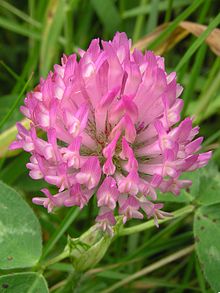
Edible properties aside, it baffles me why anyone would want to nuke a nitrogen-fixing plant from their lawn. Yet some still consider this short-lived, perennial legume a weed. It has a weak central tap root with numerous fibrous side branches. As its scientific name indicates (“Tri-folium”), leaves form in groups of three on the numerous stems that rise from the root centre. Tiny red to light purple, pea-shaped flowers are crowded together in a dense globe-shaped flower head which emerges from the tips of the branches.
Clover flowers and leaves are rich in vitamins and add exotic-tasting variety to mixed salads or when cooked into soups and stews. The closely related white clover (T. repens) has a milder flavour but is similarly good raw or cooked.
Variety
All these and many more edible invasives add credence to my belief that weeds are merely plants whose virtues have yet to be discovered. Or in the case of plants introduced from afar, virtues that have not yet been rediscovered. Add these backyard greens to your diet and you may soon be regretting all the sod grass getting in the way of your wild salad bar.
Want to learn more about edible “weeds”? Read about More Edible Invasives
Subscribe via RSS
